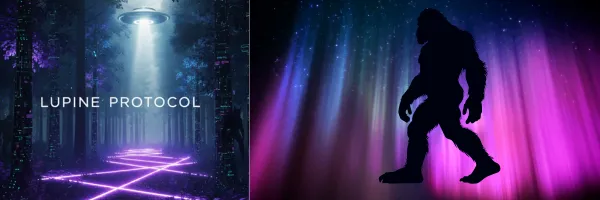

Native Traditions & Sasquatch Legends
Native Traditions & Sasquatch Legends
Table of Contents
- Introduction: More Than Just a Monster
- What Are the Sasquatch Traditions of the Pacific Northwest?
- What Are the "Wild Man" Legends of the Great Lakes and Eastern Woodlands?
- Are There Sasquatch-like Figures in Southeastern Tribal Lore?
- Do Traditions Exist in the American Southwest?
- Conclusion: A Continent of Stories
Introduction: More Than Just a Monster
Before the term "Bigfoot" was ever coined, and long before European settlers told tales of "wild men," the Indigenous peoples of North America had their own rich and complex traditions of large, hairy, human-like beings dwelling in the wilderness. These beings were not simply monsters; they were a diverse cast of characters woven into the fabric of culture, spirituality, and the natural world. They could be guardians, malevolent spirits, powerful chieftains of the forest, or even distant relatives.
Understanding these Indigenous traditions is the essential first step in any serious investigation of the Sasquatch phenomenon. These ancient stories provide the foundational context, demonstrating that the presence of these beings in the North American consciousness is a matter of millennia, not decades.
What Are the Sasquatch Traditions of the Pacific Northwest?
The Pacific Northwest is the heartland of the Sasquatch phenomenon, and the name itself comes from the traditions of this region. The word "Sasquatch" is an anglicized version of Sasq’ets, a name from the Halkomelem language of the Salish peoples of British Columbia. For these tribes, the Sasq'ets were a reality of the natural world.
The Salish Sasq’ets: The Salish peoples viewed the Sasq'ets as a type of non-human tribe that lived in the mountains. They were generally considered to be nocturnal, shy, and powerful beings to be respected and avoided. They were known to whistle, throw rocks, and communicate in a strange language, traits that are remarkably consistent with modern eyewitness reports. Far from being a myth, they were considered a simple fact of life in the deep woods.
The Kwakiutl Dzunukwa: Further north, the Kwakiutl (Kwakwaka'wakw) people have traditions of the Dzunukwa, or the "Wild Woman of the Woods." She is a giant, dark-skinned, and powerful matriarchal figure, often depicted with pursed lips to represent her cry of "Hoo! Hoo!" She could be both a dangerous ogress who stole children and a bringer of great wealth and magic to those who outsmarted her. The Dzunukwa is a prominent figure in Potlatch ceremonies and is represented in magnificent carved masks.
Other tribes in the region have their own specific names and traditions. The Yakama know of the Qah-lin-me, or "Hairy Giants," while the Chehalis tell stories of the See'atco, a race of nocturnal forest giants who were known to steal food and sometimes even people from villages.
What Are the "Wild Man" Legends of the Great Lakes and Eastern Woodlands?
While the Pacific Northwest is famous for its Sasquatch, the Algonquian-speaking peoples of the Great Lakes and Eastern Woodlands have their own powerful traditions of wilderness beings. These figures are often more supernatural in nature than the flesh-and-blood Sasq’ets of the West Coast.
The Wendigo: The most famous of these is the Wendigo (also Windigo). Unlike Sasquatch, the Wendigo is not a simple "monster" but a malevolent supernatural spirit associated with winter, cannibalism, and greed. It is often described as an emaciated, giant humanoid with a heart of ice. The Wendigo can possess humans, driving them to commit monstrous acts. While some physical descriptions align with a large, hairy creature, the Wendigo is primarily a cautionary tale and a powerful spiritual entity, not a simple biological animal.
The Stone Giants (Genoskwa): Other traditions, particularly among the Iroquois and Cherokee, speak of a race of powerful, hair-covered giants who were masters of the forest. These beings were often hostile to humans, known for their immense strength and for using stone tools or throwing large rocks. These legends are a closer parallel to the aggressive, physical Sasquatch reported in cases like the Ape Canyon Siege.
Are There Sasquatch-like Figures in Southeastern Tribal Lore?
Yes, the traditions of large, hairy hominids are not confined to the north. The Indigenous peoples of the American Southeast, a region associated with the modern **Skunk Ape**, have their own ancient stories.
The Choctaw Shampe: The Choctaw people of Mississippi and Oklahoma have stories of the Shampe, a large, foul-smelling, hair-covered creature that was to be avoided. Like the Sasquatch, it was known for its powerful screams and its habit of leaving enormous footprints.
The Seminole Esti Capcaki: In Florida, the Seminole people have tales of the Esti Capcaki, or "Tall Man," a giant, hairy being that was considered a powerful and dangerous inhabitant of the swamps. These stories form the deep historical context for modern sightings of the Florida Skunk Ape.
Do Traditions Exist in the American Southwest?
Yes, while less common, traditions of hairy, wild humanoids are also found among the tribes of the arid Southwest, a region known for the modern **Mogollon Monster** legend.
The Navajo "Hairy Ones": The Diné (Navajo) people have stories of the Tsé ninàhalééh, or "Hairy People," who are said to live in remote mountain canyons and caves. They are described as large, powerful beings who are generally reclusive but can be dangerous if disturbed. They are considered to be a different kind of people, not animals, who live by their own ancient rules.
Apache "Wood People": The Apache tribes of Arizona and New Mexico have traditions of "Wood People" or "Bush Men." These beings are often described as tall, hairy figures who would sometimes emerge from the forest at night to watch human camps from a distance, occasionally letting out powerful howls before disappearing back into the wilderness.
Conclusion: A Continent of Stories
The consistency of these traditions across a vast and culturally diverse continent is remarkable. From the Pacific coast to the Florida swamps, Indigenous peoples have a long and detailed history of encounters with large, hairy, bipedal beings. While the specific names and cultural roles of these figures vary—from physical beings to supernatural spirits, from peaceful relatives to dangerous monsters—the core physical descriptions of a tall, hair-covered, human-like creature remain strikingly similar.
This deep well of Indigenous knowledge confirms that the Sasquatch is not a modern phenomenon. It is an ancient and integral part of the North American landscape and its history, a story told for countless generations before the first European ever set foot on the continent.
Explore The Mysteries
welcome to the central archive. Lupine Protocol is a unified platform dedicated to the methodical investigation of unexplained phenomena. We bring a data-driven, evidence-based approach to the subjects that exist on the fringes of conventional science. Whether you're a seasoned researcher or a curious newcomer, our mission is to provide the resources, tools, and in-depth analysis you need to explore the world's most enduring mysteries.

Cryptozoology

UFO/UAP

The Unexplained

"Whether you're documenting the undocumented, investigating the inexplicable, or just addicted to the unknown—this is where legends are born."

Pages
Listed On


Information

© 2025 ward media projects - All Rights Reserved.



